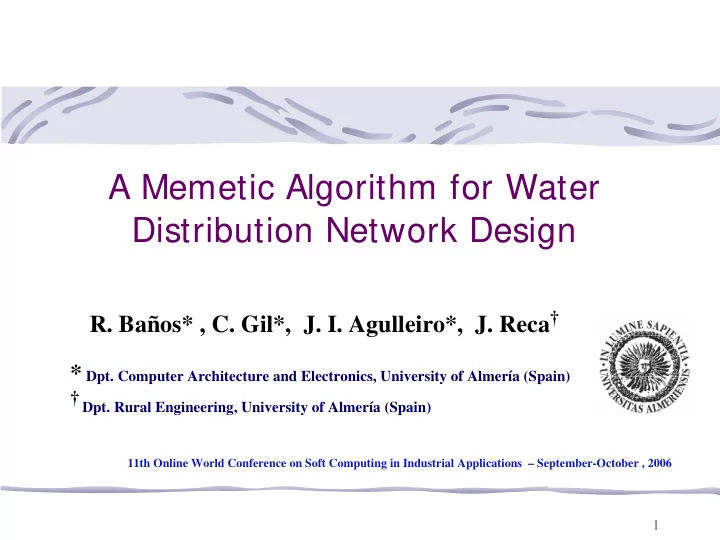

A Memetic Algorithm for Water Distribution Network Design R. Baños* , C. Gil*, J. I. Agulleiro*, J. Reca † * Dpt. Computer Architecture and Electronics, University of Almería (Spain) † Dpt. Rural Engineering, University of Almería (Spain) 11th Online World Conference on Soft Computing in Industrial Applications – September-October , 2006 1
Summary Water distribution network design (WDND) Description of the problem Formulation A new memetic algorithm for WDND MENOME (MEta-Heuristic pipe Network Optimization ModEl) Flow diagram Interface Experimental analysis Test networks Parameter settings Results at Alperovits and Shamir’s network Results at Hanoi network Conclusions and future work 2
Water distribution network design (WDND) Description of the problem Goal: find the best way in term of investment cost of conveying water from the sources to the users, satisfying their requirements. Variables imposed in the model: Network connectivity, Capacity of the tanks, Power of the pumps, Pressure required. Decision variables: Pipe diameters. 3
Water distribution network design (WDND) Formulation WDND: minimize fitness function “F” where: F is the cost function, m is the number of pipe diameters, c i is the cost of the pipe with diameter i per unit of length, L i is the total length of pipe with diameter i in the network, c p is a penalty coefficient, hr j is the required presure head in the node j , h j is the current presure head computed by EPANET for node j . 4
A new memetic algorithm for WDND Techniques for solving WDND Linear programming techniques, Non-linear programming techniques, Heuristic methods: Genetic Algorithms, Simulated Annealing, Tabu Search, Ant Colony Optimiation, Scatter Search, ………… 5
A new memetic algorithm for WDND Flow diagram of the memetic algorithm for WDND Get input parameters Initialize population of agents (P) Apply Local_Optimizer to P YES YES Stop condition? NO NO Obtain children from parents (Reproduction process) Apply Local_Optimizer to the new children Update P using new children Evaluate convergence of solutions using the Entropy of P Is there convergence? YES YES NO NO Re-initialize population Return best solution found in the search 6
MENOME (MEta-Heuristic pipe Network Optimization ModEl) Flow diagram Network Configuration Pipeline Database Reader module of Database management module EPANET file formats (ActiveX Data Object) Main program in Visual Basic (includes meta-heuristic optimizers) DLL DLL Graphical Network solver interface EPANET 2.00.07 7
MENOME (MEta-Heuristic pipe Network Optimization ModEl) 8 MENOME interface
Experimental analysis analysis Experimental Test Networks: Alperovits and Shamir network [3] 2 [2] 1 [1] 7 3 4 [5] [4] 8 5 [7] 6 [6] 2 loops, 7 nodes, 8 pipes, 1 reservoir, 0 pumping stations, 14 commercial diameters available � 14 8 = 1,4758·10 9 possible configurations, 9
Experimental analysis analysis Experimental Test Networks: Hanoi network 12 [12] [13] 11 [11] 10 [16] 33 34 26 27 28 15 14 13 9 [31] [32] [9] [25] [26] [27] [14] [15] [10] 16 8 32 [17] 25 [8] 17 [30] [18] [24] 7 18 31 [7] 24 [19] 6 19 [6] [29] [20] [4] [5] [28] [23] [3] 29 23 30 20 3 4 5 21 2 [21] 1 [2] 22 [1] [22] 3 loops, 32 nodes, 34 pipes, 1 reservoir, 0 pumping stations, 6 commercial diameters available � 6 34= 2,8651·10 26 possible configurations, 10
11 Experimental analysis analysis Parameter settings Experimental
Experimental analysis analysis Experimental Results in Alperovits and Shamir’s network All the methods reach the minimum cost. On average of 10 runs: MA outperforms to the other methods (all the configurations reach 419.000 monetary units). Difference among methods is, on average, lesser than 1.7%. 12
Experimental analysis analysis Experimental Results in Alperovits and Shamir’s network All the methods reach 419.000 monetary units, although SA converge faster 13
Experimental analysis analysis Experimental Results in Hanoi network MA obtains the best investment cost (6295909) while other methods are more expensive. On average of 10 runs: MA outperforms to the other methods Difference among methods is, on average, lesser than 1.95%. 14
Experimental analysis analysis Experimental Results in Hanoi network MA obtains best results than other methods. Although the difference, in percentage, is small, in layout problems it becomes important. 15
Conclusions and future work Conclusions New memetic algorithm for Water Distribution Network Design (WDND). Comparative study of memetic algorithms with other heuristic approaches. The memetic algorithm here proposed works better than other heuristics. When the problem instance grows, the memetic algorithm performs better. Future work Multi-objective treatment of this problem considering reliability. Extend the formulation to consider other designing aspects (connectivity, etc.) 16
QUESTIONS? COMMENTS? 11th Online World Conference on Soft Computing in Industrial Applications – September-October , 2006 17
Recommend
More recommend